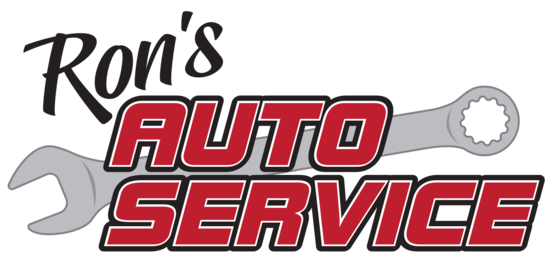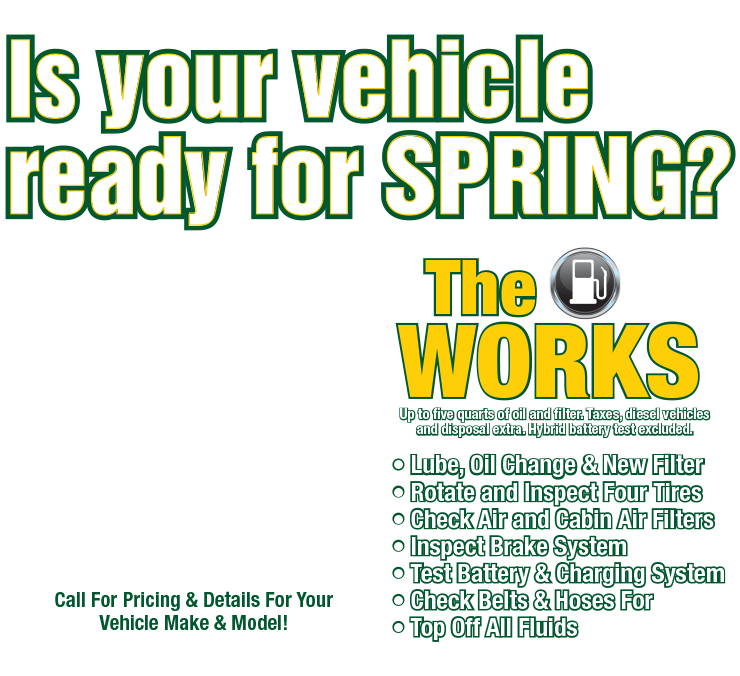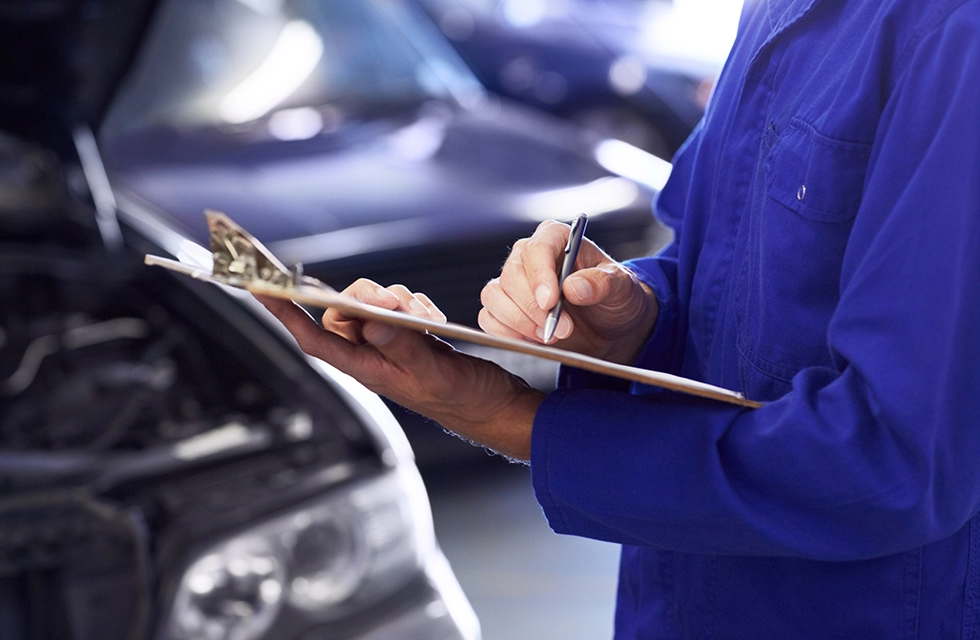This page provides answers to some of the most frequently asked questions about vehicle repair and service. We've thrown in some of our favorite tips and recommendations, too. Please call us or consult our Contact Us page for answers to your specific questions. We are happy to assist you!
Tires
-
How much air should I put in my tires?
Proper inflation is the single most important part of tire care. Check or adjust inflation every few months and always use the inflation recommended by the vehicle manufacturer. Checking air pressure should be standard procedure on any routine visit to your vehicle service center for oil services, tire rotations, or general maintenance and repair.
For do-it-yourselfers you can find this information in your owner's manual, posted on the edge of the driver's door, on a door post, in the center console, or on the inside of the glovebox door. Be sure to check inflation when tires are COLD: when the vehicle has been driven less than a mile or one hour or more after driving. Use a good quality tire gauge. And don't forget to check the spare!
-
Is it safe to repair a flat tire?
If a tire loses all or most of its air pressure, it must be removed from the wheel for a complete internal inspection to be sure it's not damaged. Tires that are run even short distances while flat are often damaged beyond repair. Most punctures nail holes, or cuts up to 1/4 inch which are confined to the tread may be satisfactorily repaired by trained personnel using industry-approved methods. Don't repair tires with tread punctures larger than 1/4 inch, or with any sidewall puncture. Also, never repair tires that are worn below 1/16 inch tread depth. Your Advisor and tire technician can advise you.
-
How important is wheel alignment?
It is very important! Having your wheels aligned helps in prolonging the life of your tires. Research indicates that the average car is driven about 12,000 miles per year. A car with toe alignment just 0.34 degrees (Just 0.17 inches) out of specification has dragged its tires sideways.
-
How often should I have my car aligned?
Vehicle manufacturers as a general rule recommend an annual alignment check. Unless there are obvious handling or wear problems this may not be necessary. As a general rule, have your vehicle aligned with every set of new tires, any suspension or steering part replacements, and at least every two years.
-
An illuminated light on my dash shows that I have a low tire. Can I just put air in it?
In many cases correcting the air pressure in your tires will extinguish the Tire Pressure Monitoring System (TPMS) warning light. Often seasonal temperature drops will lower tire air pressure a few pounds (a good case for Nitrogen – see 11 above) and trigger the TPMS warning light. In all cases where one or two particular tires are significantly lower than the others, or lower than the factory recommended pressure, a trained tire technician should examine the tire to determine the cause and examine the casing for signs of over stress. Some TPMS systems require special tools to access the vehicle computer. Advanced level tire technicians are trained and equipped for this technology.
-
With so many brand options and price differences why not just pick the cheapest tire. Is there really a difference?
The old adage: you get what you pay for is true in tire purchasing – somewhat! Since the introduction of the “radial tire” the assumption is that no significant changes have occurred in the world of tire building.
The facts are that major tire builders are spending tens of millions of dollars annually in research to improve their products and the reliability and performance of tires have taken a quantum leap forward. Research in the area of tread compounding polymers, rubber mixing methods, tread design, casing design and materials, build processes, and other research has resulted in a product that is far advanced from the tires we were driving on a decade ago. The discovery of Silica’s use in tread rubber compound alone has greatly influenced wear and adhesion characteristics of tires. Some of today’s tires can stop a car on a wet highway in distances unfathomable a decade ago. Tire builders strive to produce a product that balances production costs against safety, noise, ride quality, wear, handling, rolling resistance, and other attributes. Their cheapest products will not much focus on safety and other technologies that better tires have to offer. Conversely the higher priced lines often fall short of the best features. Knowledgeable Tire Sales Advisors can discuss test data and sort through the claims that manufacturers make regarding their products and help you make this important decision.
Vehicle Maintenance
-
What are the consequences of postponing maintenance?
Many parts on your vehicle are interrelated. Ignoring maintenance can lead to trouble: specific parts, or an entire system, can fail. Neglecting even simple routine maintenance, such as changing the oil or checking the coolant, can lead to poor fuel economy, unreliability, or costly breakdowns. It also may invalidate your warranty. Properly maintaining your vehicle is less expensive than repairs from negligence.
-
If I don't take my car to my car dealer for maintenance or repair will I void my warranty?
As a vehicle owner you should know about the Magnuson Moss Warranty Act. In 1975 the US Congress passed the Magnuson-Moss Warranty Act – a federal law that governs consumer product warranties. Among other things Congress wanted to ensure that consumers could get complete and straight forward information about warranty terms and conditions. In short the Magnuson-Moss Act gives you these rights.
Generally your vehicle manufacturer’s warranty cannot require you to return to your auto dealer for vehicle maintenance – or to use only the brand of replacement parts offered by that dealer.
By law your vehicle’s manufacturer’s warranty will stay in effect when you have regularly scheduled maintenance performed at a qualified facility that use appropriate parts and procedures.
-
My check engine or service engine soon light comes on. What should I do?
When you first start your car all the dashboard lights come on as a safety test. These lights will go off when the test is complete. If your light comes on later you need to have it checked by a competent technician familiar with modern diagnostic procedures. This could be a simple problem, but left alone it may result in an expensive repair. Don’t ignore this warning.
-
What does it mean if my "check engine" or "service engine soon" light comes on?
There are many sensors and computerized components that manage your vehicle’s engine performance and emissions. When one of these fails, the "check engine" light is illuminated. Although your car may seem to run fine, it is important to have the issue addressed to prevent long-term problems.
Vehicle Fluids
-
I see a fluid leak under my car, what is it?
You can identify fluids by their color and consistency:
• Yellowish green, pastel blue or florescent orange colors indicate an overheated engine or an antifreeze leak caused by a bad hose, water pump or leaking radiator.
• A dark brown or black oily fluid means the engine is leaking oil. A bad seal or gasket could cause the leak.
• A red oily spot indicates a transmission or power-steering fluid leak.
A puddle of clear water usually is no problem. It may be normal condensation from your vehicle's air conditioner.
Oil Change
-
How often should I change my oil?
Most car manufacturers say to change your oil every 7,500 miles unless you drive in severe conditions. Severe conditions are defined as dirty or dusty roads, extremely hot or cold climates, a lot of stop and go driving, taking long trips or if you tow a trailer. If you answer yes to any of the severe driving conditions, your vehicle falls into the severe conditions category, or the 3,000 mile oil change interval.
-
When should I get my oil changed?
You should get your oil changed every 3000 miles or as recommended in your vehicle’s owner’s manual.
-
What is that milky brown engine oil?
Milky brown engine oil is an indication of coolant in the oil. This can be caused by a blown head gasket (other gasket), a failed transmission cooler, or cracked casings. This condition is very serious and needs to be checked by a professional technician quickly.
-
What is synthetic motor oil?
Synthetic motor oils can be a good choice for high output, turbocharged or supercharged engines, vehicles that are used for towing (especially during hot weather), or vehicles that are operated in extremely cold or hot climates.
Synthetic motor oils, though several times more expensive than mineral-based motor oils, can improve fuel economy and provide longer intervals between changes. They also provide instant lubrication on start-up.
Fuel System
Cabin Air Filters
-
What is a Cabin Air Filter?
Cabin air filters filter the air that comes from the outside of a vehicle into the passenger compartment. They were originally designed to remove solid contaminants like dust and soot from circulating inside the vehicle. These filters can now also absorb gases and odors. Cabin air filters may also be known as passenger compartment filters, pollen filters, or dust filters.
-
When did Cabin Air Filters come into being?
Cabin air filters first appeared in European vehicles in the mid-1980's. They began appearing in North American vehicles in 1994.
-
Is a Cabin Air Filter the same as an engine intake filter?
While most cabin air filters look like simple panel filters that are used to filter air to the engine, they are much more technologically advanced and contain an entirely different filtering media. Basically, engine intake filters protect engine components, whereas cabin air filters protect your lungs.









